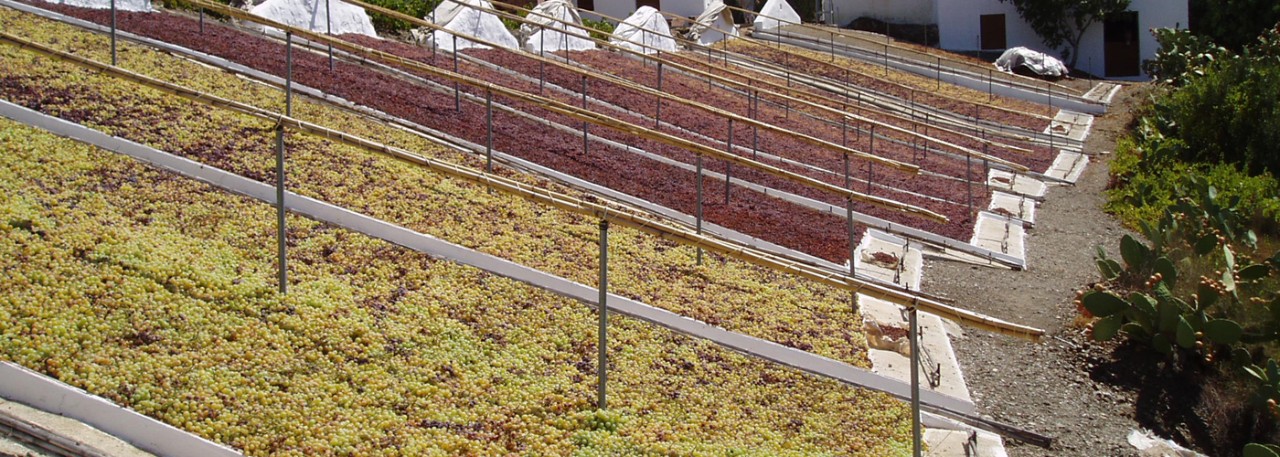.png.transform/rendition-xs/image_image%20(1).png)
Pasas de Málaga PDO
Traditional Pasas de Málaga are obtained from sun-drying the ripe fruits of Vitis vinífera L., Muscat of Alexandria variety, also known locally as Moscatel Gordo or Moscatel de Málaga.
Tasting notes
The raisins still retain the muscat flavor of the grapes from which they are obtained, reinforced by an intense afterflavor. Its characteristic sweetness is counteracted by its noticeable acidity, giving it a distinctive acid-sweet balance. Depending on their size, moisture content and characteristic Brix, the raisins have an elastic and supple feel and their flesh is meaty and juicy in the mouth, resulting in tactile sensations that are not normally produced by the dry, unsupple nature of most dried fruit. Their color is an even violet black. As the raisins come from a berry that has not been subjected to treatments that break down the skin, this is of medium texture. The raisins may have stalks if they have been picked by hand. They still have their pips inside, and these are considered to be an extra source of fiber.
Other notes
- The moisture content of these raisins is less than 35%.
- The sugar content is greater than 50% p/p.
- Acidity is between 1.2 and 1.7% in tartaric acid.
- pH is between 3.5 and 4.5.
- Water soluble solids at over 65º Brix.
Production / Processing method
Growing methods:
Maximum planting density is 5,000 vines per hectare. Training and pruning the vines is carried out depending on the pattern used and the agro-environmental conditions of each vineyard. The vines are pruned and trained following traditional methods, either in spur or goblet, or in trellis systems with one or two wires, the Guyot system or variants of these methods.
The maximum number of shoots left on each vine in all cases is 18.
For goblet-pruned vines, the number of canes per branch can vary between 4 and 8, with two shoots on each cane.
Harvesting:
Only healthy grapes harvested or picked directly from the vine - and never prior to the phenological ripening stage (Baggiolini, 1952) - are used for producing the raisins protected by this Designation of Origin.
Any red fruit that is not healthy enough or that has dropped onto the ground before harvesting cannot be used for making the protected raisins. Maximum production allowed is 8,500 kilos of grapes per hectare.
Drying:
The raisins are dried by exposing them to direct sunlight, as artificial drying floors are banned. The drying process is carried out entirely by hand on a daily basis, and farmers have to turn the all the bunches laid out to ensure that they dry evenly on all sides. The end of the drying period never extends beyond 30 November of each year.
Once the bunches have been dried, the raisins are separated from the stalks using a process called "picado", which is either done by hand or by mechanical means in industrial production plants.
Production (industry):
Industrial raisin producers carry out the following tasks before the packaged raisins are sold:
Reception and storage of raisins supplied by growers.
Separation of the fruit from the stalks, if this has not already been done by the grower.
Sorting by average fruit size, measured as number of raisins per 100 grams of weight.
Production, understood as making up batches of previously sorted and stored product, but always with the final result of less than 80 fruits per 100g net weight.
Packaging:
By hand or using mechanical methods. This is the final stage of production and is a decisive factor in safeguarding the quality standards of the raisins protected by this D.O.
Raisins obtained in the drying process inevitably continue to develop. This means that the only way of preserving the delicate balance of moisture that is the hallmark of this product is by isolating it from the surrounding environment in clean and well-sealed packaging, so it is absolutely essential that the fruit is correctly handled in the first few weeks. Packaging at source is clearly aimed at maintaining the organoleptic properties of the product intact over time.
Geography / Relief and climate
Relief: The geography of the terrain is very varied, although the soil is generally loamy and found at altitudes of between 100 and 600 meters, with vines growing on very steep slopes, excessively steep, in fact, for intensive farming methods.
Soil: The soils in the Pasas de Málaga production area are fairly similar, quite shallow and resulting from the breakdown of the shale typically found in this area. They are relatively heteregeneous and fairly shallow. They are chemically very homogeneous, low in nutrients and with a neutral pH (they are not normally chalky).
Climate: The entire production area has mild winter temperatures, and a significant absence of frost. Summers are hot, with the highest temperatures occurring in July. Average annual temperatures vary between 14º-15ºC and the weather is generally mild with no marked extremes. Rainfall is very typical of Mediterranean regions, with an irregular spread both in geographical and weather terms, but average rainfall can vary between 375mm and 450mm per year. The so-called "terral" wind is perhaps the strongest and most typical in the region and is reponsible for major damage to crops in summer.
Water supply: Water flows abundantly along a huge number of streams and other water courses, but these only fill after copious rainfall, remaining dry for the rest of the year.
Regulatory Council
Consejo Regulador de la DOP Pasas de Málaga
Plaza de Viñeros, 1
29008 Málaga (Andalusia)
Tel.: + 34 952 227 990
info@vinomalaga.com
www.vinosypasasdemalaga.com
Sources:
- Spanish Ministry of Agriculture
The raisins are dried by exposing them to direct sunlight.


- Pasas de Málaga 1
- Pasas de Málaga 2

Málaga (Andalusia)
